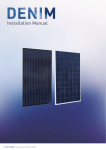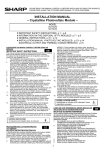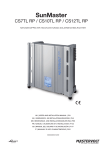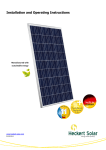Download PE module installation manual for 72m
Transcript
Installation Manual Installation manual for PerfectEnergy Solar Modules Content 1. 2. 3. 4. 5. 6. 7. Preface Technical data/General Safety instructions Mechanical Installation Electrical installation Grounding Maintenance 1. Preface The solar modules use the photovoltaic principle to turn light into electricity. PerfectEnergy solar modules are primarily designed for connection to an inverter to feed the energy into the public power grid. When connecting to an inverter, please observe the instructions of the inverter-manufacturer. When connecting to a charge controller, please observe the instructions of the manufacturer of the charge controller and accumulator. These instructions contain information about safe handling and about the installation of framed solar modules by Perfectenergy in outdoor open spaces (fields) or on flat or tilted roofs. They are only for specialists, who are familiar with the installation due to their vocational qualification, and they contain safety-relevant instructions for the assembly, connection and maintenance of the solar modules. Important Notice: The installation of the solar modules and especially the electrical installation may only be carried out by personnel with electro-technical qualifications. Appropriately qualified technicians must always be deployed to service the units or remedy faults during operation. The installation techniques, handling and use of this product are beyond company control. For this reason, Perfectenergy accepts no liability for damage arising through improper use or incorrect installation, operation, use and maintenance. Please read these instructions carefully before handling the solar modules and familiarize yourself with the safety information. After the modules have been installed, hand over these instructions to the operator of the PV-system for safe-keeping. Last revised: January 2011 The technical specifications are subject to change without notice page 1 Installation Manual 2. Technical Data Type designation PEM-160/X-72M PEM-180/X-72M-SCC Electrical Data (rated at Standard Test Conditions: Irradiance 1000 W/m²; Air mass 1.5; Temperature 25°C) Nominal Power (P) 170 W 175 W 180 W 180W 185W 190W Mpp-Voltage (Vmpp) 35,6 V 35,9 V 36,3 V 36,4 V 36,7 V 36,9 V Open Circuit Voltage (Voc) 44,3 V 44,6 V 44,7 V 44,8 V 45,0 V 45,4 V Mpp-Current (Impp) 4,77 A 4,88 A 4,95 A 4,95 A 5,05 A 5,16 A Short-circuit-current (Isc) 5,12 A 5,20 A 5,28 A 5,29 A 5,37 A 5,51 A Maximum over-current 10 A 10 A Temperature coefficients [%/°C] Power (αP) -0,49 -0,49 -0,49 -0,49 -0,49 -0,49 Open Circuit Voltage (αVoc) -0,34 -0,34 -0,34 -0,34 -0,34 -0,34 Short-circuit-current (αIsc) +0,03 +0,03 +0,03 +0,03 +0,03 +0,03 Mechanical Data Measurements 1580 x 808 x 45 mm 1580 x 808 x 45 mm Weight 15,5 Kg 15,5 Kg Maximum load 5400 Pa 5400 Pa The power output is subject to a manufacturing tolerance of ± 3%. The dimensions are subject to a manufacturing tolerance of ± 2 mm. The technical specifications are subject to change without notice. General: Solar modules generate electricity as soon as they are exposed to light. The voltage of a single module is less than 50VDC. If several modules are connected in series, the voltages of the individual modules accumulate and can pose a hazard. The modules are qualified for application class A: Hazardous voltage (IEC 61730: > 50V; EN61730: >120V), hazardous power applications (>240W), where general contact access is anticipated. Modules qualified for safety through EN 61730-1 and -2 within this application class are considered to meet the requirements of Safety Class II. The maximum system voltage of solar modules connected to each other may not exceed 1000 VDC. Under normal conditions, a photovoltaic module is likely to experience conditions that produce more current and/or voltage than reported at standard test conditions. Sunny, cool weather and reflection from snow or water can increase current and power output. Accordingly, the values of Isc and Voc marked on this module should be multiplied by a factor of 1.25 when determining component voltage ratings, conductor current ratings, fuse sizes, and size of controls connected to the PV-output. Our products are not intended for use where artificially concentrated sunlight is applied to the module. Last revised: January 2011 The technical specifications are subject to change without notice page 2 Installation Manual 3. Safety instructions The assembly and commissioning of the solar modules may only be carried out by those, who are qualified to correctly and safely install the system. Pay attention to the local ordinances, building standards and accident-prevention regulations. The safety information for other system components must also be followed. Do not install or handle the modules when they are wet or during periods of high wind. Use suitable fall-protection equipment. Secure work materials to prevent articles from falling. Secure the working area to avoid accidents with other people. Never install damaged solar modules! Before installing, check the junction-box, cables and socket connectors for damages. Never use the junction-box or the solar cable to carry the unit. Do not apply paint or any adhesives to the rear side of the solar module. Do not allow any objects to fall upon the solar module. Avoid scratches to the front glass. Do not walk across or step on the solar module! If the front glass is broken, or the backsheet is torn, contact with any module surface or module frame can cause electric shock. Cover all modules in the PV array with an opaque cloth or material before making or breaking electrical connections. Electrical commissioning of the solar modules may only be carried out by a professional installer! Do not connect or disconnect modules when current from the modules or an external source is present. Remove all metallic jewelry prior to installing this product to reduce the chance of accidental exposure to live circuits. Only use dry, insulated tools for the electrical assembly work. Ensure that the cable connections are in perfect condition (no cracking, soiling or other contamination). Pay attention to the inverter manufacturer’s installation instructions! Before starting work on a PV-system, switch it off with a disconnection switch. Working with conductors, which conduct direct current can cause electric arcs! When installed on a roof, the module shall be mounted over a fire-resistant roof covering rated for the application. Solar modules are considered as „non-explosion-protected-equipment“. Hence, they must neither be installed near highly flammable gases and vapors (e.g. filling stations, gas containers, paint spraying equipment), nor near open flames or flammable materials. Last revised: January 2011 The technical specifications are subject to change without notice page 3 Installation Manual 4. Mechanical installation 4.1 Location The solar modules can be installed on roofs or open spaces on support structures. Please pay attention to the local ordinances, building-standards and accident-prevention regulations during installation. The attachment must be sufficiently dimensioned to cope with the location’s load requirements. To obtain maximum yield from the system, all modules should have the same direction and tilt-angle, and the solar irradiation should strike the modules perpendicular to their surface. In the northern hemisphere, the surface of the solar modules must face south. In Europe, the ideal module slope is approx. 30°-40°. The solar modules should not be exposed to shadows cast by trees or buildings as this would lead to energy losses! Even partial shading will cause a yield reduction! A module is “shade free“, when the entire surface is shade free all year round and, even on the most unfavorable days of the year, receives unobstructed sunlight. The solar modules must not stand in water. There is a risk of corrosion with exposure to salt (it is recommended that modules are installed at least 500m from the sea) and sulfur (sulfur sources, volcanoes). The modules may not be exposed to extremely corrosive chemicals (e.g. emissions from manufacturing plants). When installed on a roof, the module shall be mounted over a fire-resistant roof covering rated for the application. 4.2 Instructions for mounting Assembly work may only be performed by trained and qualified personnel. Fasten modules firmly to a support structure designed to withstand the local wind and snow loads. When selecting the material for the support structure, pay attention to the electrochemical series in order to avoid galvanic corrosion between different kinds of metal. A clearance of at least 20mm needs to be kept between the module frame and the attachment surface. This allows the cool ambient air to circulate below the solar module. Ventilation of the module backside is necessary to avoid the build-up of heat that can reduce performance. There should be a clearance of at least 5mm between the individual module frames to allow heat-related expansion. Do not remove or alter the module frame. Please use the existing mounting holes and do not drill any new holes into the frame! (doing so would void the warranty) The module clamps, which are used must not touch or shade the front glass and must not deform the frame. The solar modules may be mounted at any angle from horizontal to vertical. Each module must be securely fastened at a minimum of 4 points. Last revised: January 2011 The technical specifications are subject to change without notice page 4 Installation Manual 4.3 Mounting requirements The PerfectEnergy-modules described in this manual are designed to meet a maximum positive (or upward, e.g. wind) and negative (or downward, e.g. snow) load of 5400 Pa (Pascals; 540 kg/m²) when mounted in one of the following mounting configurations. A design-strength of 5400 Pa corresponds approximately to a wind speed of 500 Km/h (300 mph). PEM-160/X-72M PEM-180/X-72M-SCC Screw attachment Secure the module to the structure using the factory mounting holes. Four M8 stainless steel bolts, with nuts, washers, and lock washers are recommended per module. Refer to the drawing on the right for the module dimensions and mounting-hole locations. Clamps When mounting the modules horizontally, the higher load limit („Heavy Snow Load“) of 5400Pa is only guaranteed, if the frames are supported additionally in the middle of the module! = admissible clamping-range Last revised: January 2011 The technical specifications are subject to change without notice page 5 Installation Manual 5. Electrical connection Only specially trained and qualified personnel may make the electrical connection! The maximum system voltage of solar modules connected with each other may not exceed 1000VDC! When designing the system, please note that the module voltage increases when the temperatures are low. Only connect solar modules of the same type and power category with each other. For the electrical connection, the solar modules are equipped with a junction box and solar cables with plugs. The plugs are marked with the respective polarity. Ensure that the polarity is correct and that the connections are secure and tight. Never connect or disconnect electrical contacts when under load! Always use special solar cables with a diameter of at least 4 mm² for further wiring. We recommend securing the cables to the mounting system, using UV-resistant cable ties, to avoid the pin and socket connections being at a water-settlement level. The junction-boxes are equipped with 3 bypass-diodes. In the event of clouding, these minimize the losses and help to prevent damage to the solar modules. When connecting the solar modules to an inverter, please observe the information provided by the manufacturer of the inverter. 6. Grounding The company installing the solar module frame is also responsible for proper grounding. If the building is already equipped with an exterior lightning protection system, the PVinstallation must be integrated in the protection system against direct effects of lightning. Country specific standards must be adhered to. Attach a separate conductor as grounding wire to one of the 4mm diameter grounding holes on the module frame with a set of M4 bolt, cup washer, flat washer, tooth washer and M4 nut. This is to ensure positive electrical contact with the frame. For the position of the grounding holes, please refer to the technical drawing in paragraph 4.3. Ensure that the anodized layer of the frame is penetrated and a secure electrical contact is created with the frame. Drawing: Last revised: January 2011 The technical specifications are subject to change without notice page 6 Installation Manual 7. Maintenance Perfectenergy solar modules are designed for long-term service and are almost maintenancefree. When the slope is adequate (>15°), the solar modules do not need to be cleaned thanks to the self-cleaning effect of rain. In case of heavy soiling, we recommend cleaning the modules using plenty of water, without any cleaning agents and using a gentle cleaning implement (cloth or sponge). Do not use harsh cleaning materials such as scouring powder, steel wool, scrapers, blades, or other sharp instruments to clean the glass surface of the module. Use of such materials will invalidate the product warranty! The PV-system should be inspected once a year with regard to the following: Secure hold and no rust on any of the attachments. Secure connection, cleanliness and that all cable connections are free of corrosion. Soundness of cables and front glass. For further information, actual datasheets, terms of warranty, certificates, etc., please visit our website: www.perfectenergy-gmbh.de Contact: PerfectEnergy GmbH Tannenweg 8-10 53757 Sankt Augustin Tel: +49 (0)2241-23425-0 Fax: +49 (0)2241-23425-10 Email: [email protected] Web: www.perfectenergy-gmbh.de Last revised: January 2011 The technical specifications are subject to change without notice page 7
















